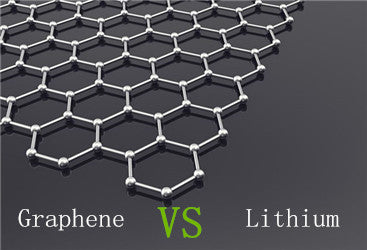
Lithium VS Graphene battery, What is the difference
In new energy electric vehicles, batteries are the core of the core. At present, the mainstream batteries for electric vehicles are lithium batteries and graphene batteries. The graphene battery is a new energy battery developed by using the characteristics of lithium ions to shuttle between the graphene surface and the electrode quickly and in large quantities. The working voltage of the lithium battery changes greatly.
What is the difference between lithium batteries and graphene batteries?
Graphene battery: Graphene battery is a honeycomb flat film formed by sp2 hybridization of carbon atoms. It is a quasi-two-dimensional material with only one atomic layer thickness, so it is also called monoatomic layer graphite. A new energy battery has been developed by using the characteristics of rapid and massive shuttle movement of lithium ions between the graphene surface and the electrodes. Due to the characteristics of high conductivity, high strength, ultra-light and thin, the application advantages of graphene in the aerospace and military industry are also extremely prominent.
Graphene is hailed as the "king of new materials" by researchers and major media. It is a new type of nanomaterial known to mankind with high strength, good toughness, light weight, high light transmittance, and good conductivity.

Lithium battery: "Lithium battery", the lithium ion in the lithium ion battery refers to the energy storage material in the battery, and the battery reaction (chemical change) occurs during the charge and discharge process. It is a type of battery that uses lithium metal or lithium alloy as the negative electrode material and uses a non-aqueous electrolyte solution. Lithium batteries can be roughly divided into two categories: lithium metal batteries and lithium ion batteries. Lithium-ion batteries do not contain metallic lithium and are rechargeable. The fifth generation of rechargeable batteries, lithium metal batteries, was born in 1996, and its safety, specific capacity, self-discharge rate, and performance-price ratio are better than lithium-ion batteries.
The performance of graphene batteries is much better than that of lithium batteries, especially in terms of battery power characteristics, capacity, and life span. However, graphene has not yet reached the practical stage, and there is still a long way to go before mass production. The huge shortcomings of lithium batteries in terms of safety, endurance, environmental pollution, and charging speed have begun to severely limit the development of major high-tech industries. Therefore, many corporate R&D departments have set their sights on more advanced graphene batteries. , And believe that this new battery will completely replace the lithium battery that has been around for more than 26 years in the future.
Why didn't graphene batteries replace lithium batteries?
Graphene batteries have the highest strength, best toughness, light weight and excellent electrical conductivity. As early as a few years ago, Huawei announced a fast charging technology. It only takes five minutes to charge a 3000 mAh graphene battery to nearly half the power. It can be seen that graphene batteries are not only suitable for new energy vehicles, but also can be widely used in our mobile phone field, but this is only in the experimental stage, and it takes a long way to go before it is applied in the market.
Graphene has more advantages than traditional batteries. In terms of service life, its service life is twice that of lithium batteries and four times that of hydrogenated batteries. In terms of weight, its weight is only about half of traditional batteries. In terms of charging rate. Graphene batteries can be increased dozens of times or even hundreds of times.
In fact, our market is not without graphene battery products, for example, in some high-end medical equipment. But these graphene batteries are not the pure graphene batteries that we expect. They just doped some graphene-related technologies on the basis of lithium batteries. Compared with traditional lithium batteries, it brings performance improvements. Only a little bit. In addition, the cost of graphene is very high, and its manufacturing process is also very high. It almost takes a big step to reach the stage of mass production. With such a high cost, coupled with the performance improvement, some manufacturers are naturally not interested in graphene batteries.

For the time being, graphene batteries are still immature and have not shown significant advantages over lithium batteries, so the era when lithium batteries are to be replaced may not come so early.
Graphene batteries are considered to be one of the most promising materials in the future, but for now, its foam composition is greater than the actual application value. There are many factors that hinder the popularization of this material. Mass production and cost are the most important Obstacles to popularization, graphene batteries may have a long way to go before they can completely replace lithium batteries in the short term.
Graphene batteries have considerable potential and are the best material to replace lithium-ion batteries. Due to the poor safety and fire risk of lithium batteries, graphene batteries have become a highly anticipated research direction in recent years.



Leave a comment